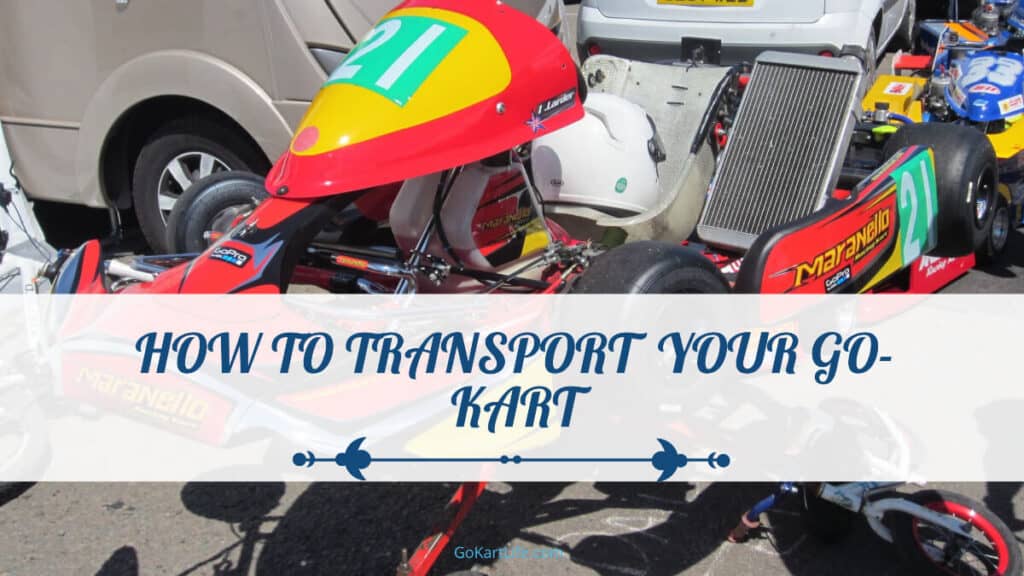Let’s be honest here – awkwardly strapping a 500-pound racing kart to the roof of your sedan gives anyone sweaty palms! Without fenders or body panels to grab onto, getting those small speedsters secured for highway travel ain’t easy.
Well, strap in friends, because in this post I’ll be breaking down the exact equipment, techniques, and vehicle hacks my race crew uses to transport even specialty drift trikes all the dang time…without a single scratch or incident (knocks on wood)!

Here’s what we’ll tackle:
- Crucial gear you need to gather beforehand (ratchet straps – heck yes)
- Clever ways to disassemble parts for easy loading
- How to safely use your existing truck, trailer, or minivan to trailer karts
- Common tie-down mistakes to steer clear of (tarp bungees won’t cut it, people)
- My quick pre-transport checks so you cruise confidently
Follow along for pro tips that’ll have you hauling your sweet go-kart like a boss! Now let’s get rollin’!
Equipment Needed
Before lugging any go-kart onto a trailer or cramming it into truck beds, you’ll want to stock up on a few key supplies. Investing in heavy-duty restraints, protective padding, and loading tools will make transportation a breeze (well…less of a hassle at least).
Here’s the essential gear to have on deck:
- Ratchet Straps or Elastic Fasteners – Thick straps rated to handle 500+ pounds with adjustable tension are crucial to keeping your kart secured. The hook-style stretchy straps add flexibility to attach to irregular frame shapes.
- Padding – Foam blocks, moving blankets, and bubble wrap layers allow you to tightly strap karts without scratching that glossy paint job.
- Loading Ramps – Low-angle ramps prevent undercarriage scrapes when rolling machines into trucks and trailers. Walkboards or plywood ramps work too.
- Furniture Dollies – Pop lightweight alloy frame sections onto dollies to effortlessly roll up ramps instead of potentially tweaking your back.
- Basic Tools – Have screwdrivers, adjustable wrenches, zip ties, and a sharp knife accessible to remove seats, tires, and body panels safely before loading.
Methods of Transportation
Alright, now for the fun stuff – how the heck do you actually go about moving your go-kart without a full-sized auto-transport trailer? Turns out there are several pretty clever options using your existing vehicles that we’ve tested out.
Related Article: How to Lift a Go-Kart
1. Using a Trailer
Of all the go-kart transportation methods, a dedicated trailer always ranks as the most convenient for our race crew. Even small 4×6 foot utility trailers offer ample covered space to securely fasten most mid-size recreational karts under 2,000 pounds.
For maximum security, we use 1-inch wide ratchet straps (rated for 500lb loads) attached to steel D-rings installed along the trailer bed frame. This allows tying down the chassis directly along with anchoring wheels front and back. Consider adding a center ratchet strap as an extra preventative measure on curvy roads.
Benefits of Trailer Transportation:
- Ratchet strap karts directly to the metal trailer bed frame or vertical supports for 6+ contact points
- Pack ample extra gear like gas cans, tools, and spare tires separately in the front
- Install welded steel D-rings along bed corners for adjustable tie-down points preventing load shifts
- The locking rear coupler and solid side panels provide full weather and debris protection
Potential Challenges to Address:
- Backing maneuvers take practice for new drivers – use colored sticks to learn trailer angles
- Low frame ground clearance risks undercarriage scrapes – approach ramps slowly at a 45-degree upward pitch
- Trailers block rearward vision from vehicles – add wide-angle side mirrors and shoulder check often
- Heavy tongue weight strains haul vehicles – distribute load further toward trailer axles
For transporting specialty racing karts, enclosed trailers offer ample height clearance to stand machines upright without detaching roll bars. Consider adding thick foam padding to interior trailer walls for an extra buffer guarding against scratches during transport. Built-in interior lighting and roof ventilation ports with fans are also nice bonuses when trailering loud, smelly gas-powered karts.
2. Back of a Pickup Truck
The truck bed provides another solid transport option for mid-size go-karts under 1,000 pounds. Just be sure to fully secure the machine before hitting the highway.
Preparing Truck Beds:
- Install steel bed caps or camper shells to protect karts from weather and road debris
- Apply anti-slip truck bed liner spray coating for traction when loading/unloading
- Anchor additional ratchet strap tie-down points along the bed sides/front
- Consider welding a center divider to separate cargo space
Securing the Go-Kart:
- Carefully load using ramps into the bed far enough for tailgate clearance
- Engage the parking brake and leave the transmission in gear during transport
- Tighten ratchet straps over both axles and frame to prevent shifting
- Use foam blocks/padding to prevent metal contact scratches
- Attach wheel straps to prevent lateral front/back spinout
Driving Considerations:
- Added height clearance for low tunnels and overpasses
- Accelerate/brake gradually to avoid bucking loads
- Increased risk of bed debris flying out – cover properly
- Rear weight distribution adds slide risk on turns/wet roads
The open truck bed allows easy drive-on access ramps. But tipsiness and exposing karts to elements remain challenges. Enclosed trailers still lead to convenience in my experience.
3. Inside a Van or SUV
Securing lightweight go-karts under 800lbs inside enclosed vehicles offers weather protection if trailers are unavailable. With thoughtful preparation, cargo vans, SUVs, and minivans can work.
Preparing the Interior:
- Measure cargo area dimensions – know go-kart length/width/height
- Remove non-critical panels, tires, and axles to consolidate the frame
- Line the floor and sides with thick blankets or foam blocks
Securing the Go-Kart:
- Verify vehicle weight capacity before loading
- Anchor parts separately in the rear with elastic straps
- Hatchback windows allow access to tie-downs
- Stand karts vertically with pickup truck bed caps
Transport Considerations:
- A high center of gravity raises tip risk on turns
- Stay within vehicle weight capacities
- Limited height clearance around a roll cage
- Gas-powered kart fumes require ventilation
Taking precautions by padding interiors and securely anchoring all go-kart components can make unconventional self-transport achievable.
4. On a Hitch Carrier
Small trailer hitch carriers offer another option for conveniently moving smaller go-karts without a full trailer. These platform racks slide right into receiver hitches on the backs of SUVs, vans, and pickup trucks.
Choosing Hitch Carriers:
- Confirm hitch receiver size – 1 1⁄4 or 2 inches for class III/IV hitches
- Low-profile racks with ramps under 20 inches off the ground
- 75-100 LB haul capacity minimum
- Safety chains and reflectors for road visibility
Loading and Securing:
- Detach non-essential bodywork to reduce wind resistance
- Carefully load centered and balanced on the racks
- Securely tie axles, frame, and wheels to prevent motion
- Consider weatherproof strapping covers
Transport Considerations:
- Added kart width needs checking for clearance
- Reduced rear visibility – add side mirrors
- Increased braking distance with rear weight
- Not intended for high-speed highway driving
For quick trips under 20 miles without a trailer, hitch carriers did the trick for us. But severe bumps risked scraped undersides. Enclosed trailers still lead for protection.
5. Top of Your Car
If interior cabin and cargo space fall short, securing go-karts on a vehicle roof rack offers another unconventional option.
Constructing Roof Racks:
- Install fixed commercial racks rated for 100+ LBS
- Build re-enforced plywood platforms spanning bars
- Screw 2×4 rails along platform edges
- Pad rails and platforms to prevent scratches
Hoisting and Securing:
- Use ramps and winch systems to safely load platforms
- Secure wheels front and back to rack rails
- Ratchet chassis frame to rack anchors
- Consider secondary safety straps as redundancy
Transport Factors:
- Wind resistance at speed impacts gas mileage
- Visually verify bridge and tunnel clearance
- Use spotters with tall vehicles in parking garages
- Avoid automated car washes
While the top of your car impresses the pit crews, exposure to weather and high lift height severely limit convenience in our experience. But hey, it looks awesome!
6. Inside the Car Trunk
Small go-karts under 500 pounds can potentially fit inside some large vehicle trunks for local transportation. With careful loading and securing, this utilizes existing space.
Considerations for Trunk Transport:
- Measure go-kart dimensions against trunk capacity beforehand
- Detach non-essential protruding components
- Ensure total weight stays within vehicle payload limits
- Pad and tape all interior trunk surfaces to prevent scratches
- Securely ratchet chassis tie-down straps to trunk anchors
- Balance weight distribution over the rear axle
Potential Challenges:
- Very limited haul weight and size capacities
- Height and width restrictions
- Rear visibility is fully blocked
- No weather protection in the open trunk
When abruptly needing to move a compact go-kart short distances without proper equipment, creatively using a large vehicle trunk space can work. But it is only recommended for lightweight machines less than 8 feet in length. Enlist spotters to safely navigate.
Loading and Unloading Your Kart
Carefully transferring go-karts onto any transport vehicle using proper techniques prevents expensive scratches or injuries. Follow essential gear prep, lifting methods, and positioning steps when hauling karts.
Pre-Transport Preparation:
- Measure all clearance dimensions – vehicle cargo depths/heights
- Gather ramps, dollies, and padding equipment beforehand
- Detach non-critical removable components like sidebars
- Make small adjustment marks for reassembly
Transferring the Go-Kart:
- Use jacks and dollies under frame sections to unload the vehicle
- Roll kart backward up loading ramps slowly with spotters
- Align axles into final front/rear positions
- Engage parking brake locks and chock wheels
Securing Positions:
- Ensure vehicle weight distribution stays balanced
- Alternating directional tie-down points prevents load shifts
- Leave cockpit access open to attach buckle straps
- Do not over-tighten straps risking frame damage
Taking a methodical, safety-first approach protects both riders and equipment from getting rolling again at the next event start line! You’re absolutely right, after providing a comparison, I should clearly state the best method. Here is a revised conclusion:
What is The Best Way to Transport a Go-Kart
After covering six go-kart haulage methods, it’s clear certain configurations offer distinct advantages over others when considering factors like weather protection, storage space, tie-down options, weight limits, and ease of loading:
| Method | Pros | Cons |
|---|---|---|
| Trailers | Highly secure, multi tie-downs, enclosed padding, gear storage | Initial cost, backing challenges, clearance limit |
| Trucks | Open bed access, can build partitions, some fender coverage | Exposed to elements, cargo unprotected, weight shift risk |
| Car Trunk | Uses existing space, ratchet to interior anchors | Very weight and size limited, no weather protection |
| Hitch Carriers | Compact, uses vehicle receiver, ramp flip-downs | No weather cover, underside scrapes, low ground clearance |
| Interior | Take advantage of dimensions, anchor to interior hooks | Tough weight distribution, height clearance, strapping access limited |
| Rooftop | Use with kaysak/ladder rack bars, winch systems available | High exposure to elements, straps prone to loosening, increased wind resistance |
Clearly, fully enclosed trailers are the best way to transport your go-kart. Their protective structure, ample and customizable tie-down points directly to the frame, storage for extra equipment, and built-in loading ramps make trailers uniquely well-suited for hauling go-karts of all sizes.
While other vehicles can certainly work in a pinch, only full-fledged enclosed trailers offer reliable weather protection, simple access, and adjustable securing configurations for versatile go-kart carrying needs.
Maintenance and Safety
Completing standard pre-haul inspections and taking safety precautions ensures go-kart transport proceeds incident-free time after time.
Equipment Checks Before Loading:
- Test parking brake lock disengagement
- Ensure tires have adequate pressure and tread
- Check fuel/oil levels (for gas-powered models)
- Inspect brake pads, rotors, and drive belts for wear
- Verify all critical fasteners are tightened
Securing and Transport Considerations:
- Redundant tie-down straps act as backups
- Anchor wheel straps at 10 and 2 o’clock angles
- Attach warning flags for oversized loads if needed
- Carefully gauge transport vehicle clearance
Unloading Safety Measures:
- Keep fire extinguisher accessible for fuel-powered karts
- Deploy wheel chocks before releasing straps
- Mind loading ramp angles during drive-off
- Check fastener torque and alignments again
Remaining vigilant by continually evaluating bindings, connections, and components arrives prepared for exciting track days ahead!
Conclusion
Listen, at the end of the day, hauling a 500lb hunk of bolt-on metal and fiberglass around without damage ain’t easy. But I’m telling ya – with the right gear, a solid plan, and maybe an extra set of muscles on deck – you can get that speed demon moved safely no sweat!
Here’s the deal…of all the truck/trailer/roof rack options we broke down, full-on enclosed trailers seriously do the job best. I’m talking wraparound padded walls, tie-downs galore, ramp access – the works! No exposed exhaust pipes, delicate spindles smashing against highway grit, or last-minute bungee-cord concoctions. Just maps, snacks, and good tunes headed for the races!
Sure an old beater pickup or Aunt Sandy’s minivan might cut it in a pinch, but do yourself a favor – rent or buy a purpose-built trailer and save the stress. Your back and your beautiful one-of-a-kind ride will thank you big time! That’s a pro-tip promise.
Now get wrenching! Those podium glory days await ??
Related Article: Average Go-Kart Weight

Goran, an experienced go-kart racer, fuels GoKartLife.com with his passion and expertise. He offers valuable insights and tips for fellow enthusiasts, fostering the growth of the go-kart community. Join Goran at GoKartLife.com and immerse yourself in this exhilarating sport.
Last modified: December 11, 2024



